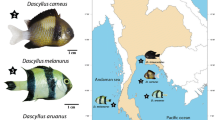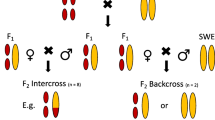Abstract
Somatic cell genetic mapping of marsupial and monotreme species will greatly extend the power of comparative gene mapping to detect ancient mammalian gene arrangements. The use of eutherian-marsupial cell hybrids for such mapping is complicated by the frequent retention of deleted and rearranged marsupial chromosomes. We used staining techniques, involving the fluorochromes Hoechst 33258 and chromomycin A3, to facilitate rapid and unequivocal identification of marsupial chromosomes and chromosome segments and to make chromosome assignment and regional localization of marsupial genes possible. Chromosome segregation in rodent-macropod hybrids was consistent with preferential loss of the marsupial complement. The extent of loss was very variable. Some hybrids retained 30% of the marsupial complement; some retained small centric fragments; and some, no cytologically identifiable marsupial material. We examined the chromosomes and gene products of a number of rodent-grey kangaroo Macropus giganteus hybrids, and have assigned the genes Pgk-A (phosphoglycerate kinase-A), Hpt (Hypoxanthine phosphoribosyl transferase), and Gpd (Glucose-6-phosphate dehydrogenase) to the long arm of the kangaroo X chromosome, and provisionally established the gene order Pgk-A -Hpt -Gpd.
Similar content being viewed by others
References
Cooper DW, VandeBerg JL, Sharman GB, Poole WE (1971) Phosphoglycerate kinase polymorphism in kangaroos provides further evidence for paternal X inactivation. Nature New Biol 230:155–157
Cooper DW, Johnston PG, Sharman GB, VandeBerg JL (1977) The control of gene activity on therian and metatherian X chromosomes: a comparison. In: Calaby JH, Tyndale-Biscoe CH (eds) Reproduction and evolution. Australian Academy of Science pp 81–87
Creau-Goldberg N, Cochet C, Turleau C, De Grouchy J (1981) Comparative gene mapping of man and Cebus capucinus: a study of 23 enzymatic markers. Cytogenet Cell Genet 31:228–239
Donald JA and Hope RM (1981) Mapping a marsupial X chromosome using kangaroo-mouse somatic cell hybrids. Cytogenet Cell Genet 29:127–137
Dutrillaux B (1979) Chromosomal evolution in primates: tentative phylogeny from Microcebus murinus (Prosimian) to man. Hum Genet 48:251–314
Elizur A, Dennis ES, Peacock WJ (1982) Satellite DNA sequences in the red kangaroo Macropus rufus. Aust J Biol Sci 35:313–325
Graves JAM (1975) Control of DNA synthesis in somatic cell hybrids. In: Peacock WJ, Brock RD (eds) The eukaryote chromosome, ANU Press, Canberra, pp 367–379
Graves JAM, Chew GK, Cooper DW, Johnston PG (1979) Marsupial-mouse cell hybrids containing fragments of the marsupial X chromosome. Somatic Cell Genet 5:481–489
Harris M (1979) Genetic and adaptive differences in the expression of drug resistance in hybrid cells. Somatic Cell Genet 5:793–808
Hayman DL, Martin PG (1974) Mammalia 1: Monotremata and marsupialia, Vol. 4 Chordata 4. In: John B (ed) Animal cytogenetics, Gebrüder Borntraeger, Berlin-Stuttgart, pp 1–109
Hayman DL, Sharp P (1981) Hoechst 33258 induced uncondensed sites in marsupial chromosomes. Chromosoma 83:249–262
Hilwig I, Gropp A (1972) Staining of constitutive heterochromatin in mammalian chromosomes with a new fluorochrome. Exp Cell Res 75:122–126
Hope RM, Graves JAM (1978) Fusion and hybridization of marsupial and eutherian cells. VI. Hybridization. Aust J Biol Sci 31:527–543
Jonasson J, Povey S, Harris H (1977) The analysis of malignancy by cell fusion. VII. Cytogenetic analysis of hybrids between malignant and diploid cells and of tumours derived from them. J Cell Sci 24:217
Kemp TS (1982) Mammal-like reptiles and the origin of mammals. Academic Press, New York
Kirsch JAW (1977) The comparative serology of marsupialia, and a classification of marsupials. Aust J Zool Suppl Ser No 52
Kozak CA, Lawrence JB, Ruddle FH (1977) A sequential staining technique for the chromosomal analysis of interspecific mouse/ hamster and mouse/human somatic cell hybrids. Exp Cell Res 105:109–177
Kucherlapati RS, Hilwig I, Gropp A, Ruddle FH (1975) Mammalian chromosome identification in interspecific hybrid cells using ‘Hoechst 33258’. Humangenetik 27:9–14
Latt SA, Juergens LA, Matthews DJ, Gustashaw KM, Sahar E (1980) Energy transfer-enhanced chromosome banding. An overview. Cancer Genet Cytogenet 1:187–196
Migeon B (1968) Hybridization of somatic cells derived from mouse and Syrian hamster: Evolution of karyotype and enzyme studies. Biochem Genet 1:305–322
Nash WG, O'Brien SJ (1982) Conserved regions of homologous G-banded chromosomes between orders in mammalian evolution: Carnivores and primates. Proc Natl Acad Sci USA 79:6631–6635
Pearson PL, Roderick TM, Davisson MT, Lalley PA, O'Brien SJ (1982) Report of the committee on comparative mapping. Cytogenet Cell Genet 32:208–220
Richardson BJ, Johnston PG, Clark P, Sharman GB (1973) An evaluation of electrophoresis as a taxonomic method using comparative data from the Macropodidae (Marsupialia). Biochem Syst 1:203–209
Rofe R (1978) G-banded chromosomes and the evolution of Macropodidae. Aust Mammal 2:53–63
Rofe R (1979) G-banding and chromosomal evolution in Australian marsupials. PhD Thesis, University of Adelaide, South Australia
Sager R, Kitchin R (1975) Selective silencing of eukaryotic DNA. Science 189:426–433
Schall D, Rechsteiner M (1978) Kinetics of human chromosome loss from 3T3-human hybrid cells. Somatic Cell Genet 6:661–676
Schweizer D (1976) Reverse fluorescent chromosome banding with chromomycin and DAPI. Chromosoma 58:397–324
Schweizer D (1981) Counterstain-enhanced chromosome banding. Hum Genet 57:1–14
Seabright M (1971) A rapid banding technique for human chromosomes. Lancet 2:971–972
Sharman GB (1961) The mitotic chromosomes of marsupials and their bearing on taxonomy and phylogeny. Aust J Zool 9:38–60
Sumner AT (1972) A rapid method for demonstrating centromeric heterochromatin. Exp Cell Res 75:304–306
Venolia L, Peacock WJ (1981) A highly repeated DNA from the genome of the wallaroo Macropus robustus robustus. Aust J Biol Sci 34:97–113
Author information
Authors and Affiliations
Rights and permissions
About this article
Cite this article
Dawson, G.W., Graves, J.A.M. Gene mapping in marsupials and monotremes. Chromosoma 91, 20–27 (1984). https://doi.org/10.1007/BF00286481
Received:
Revised:
Issue Date:
DOI: https://doi.org/10.1007/BF00286481




